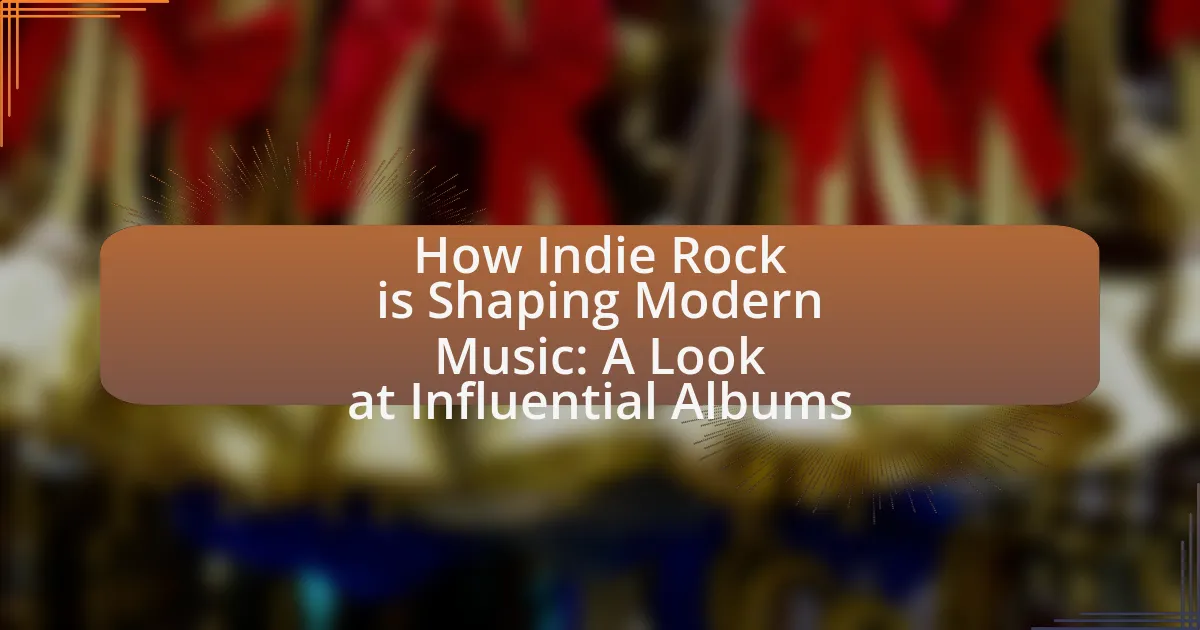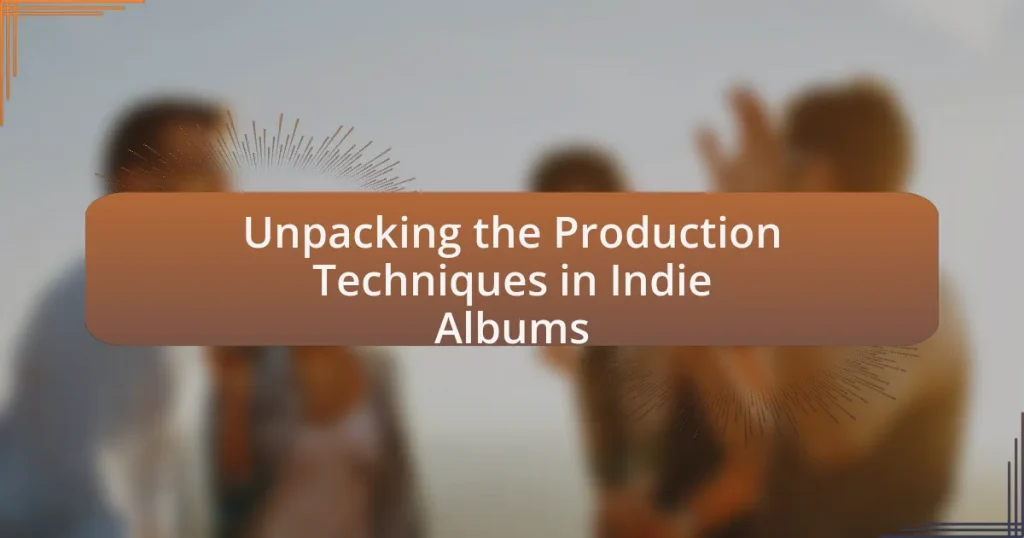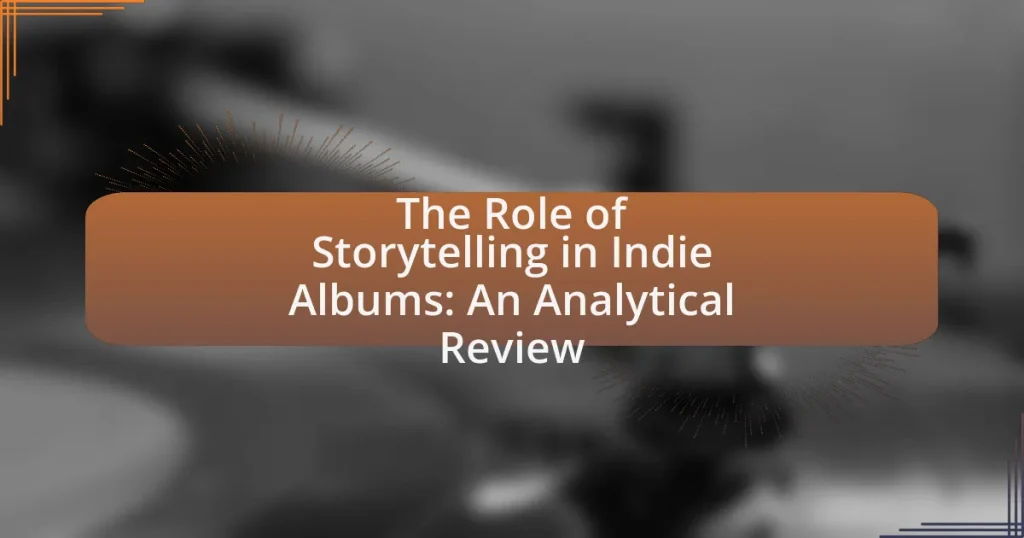Indie rock is a significant genre that has profoundly influenced modern music through its promotion of diverse sounds, DIY ethics, and lyrical authenticity. This article examines how indie rock has shaped contemporary music by encouraging artists to experiment with unconventional song structures and production techniques, as well as highlighting the role of independent labels and digital platforms in democratizing music distribution. Key influential albums, such as “In the Aeroplane Over the Sea” and “Funeral,” are discussed for their impact on songwriting and thematic exploration. Additionally, the article addresses the challenges indie rock faces in the current music industry and offers strategies for artists and listeners to support and engage with the genre.
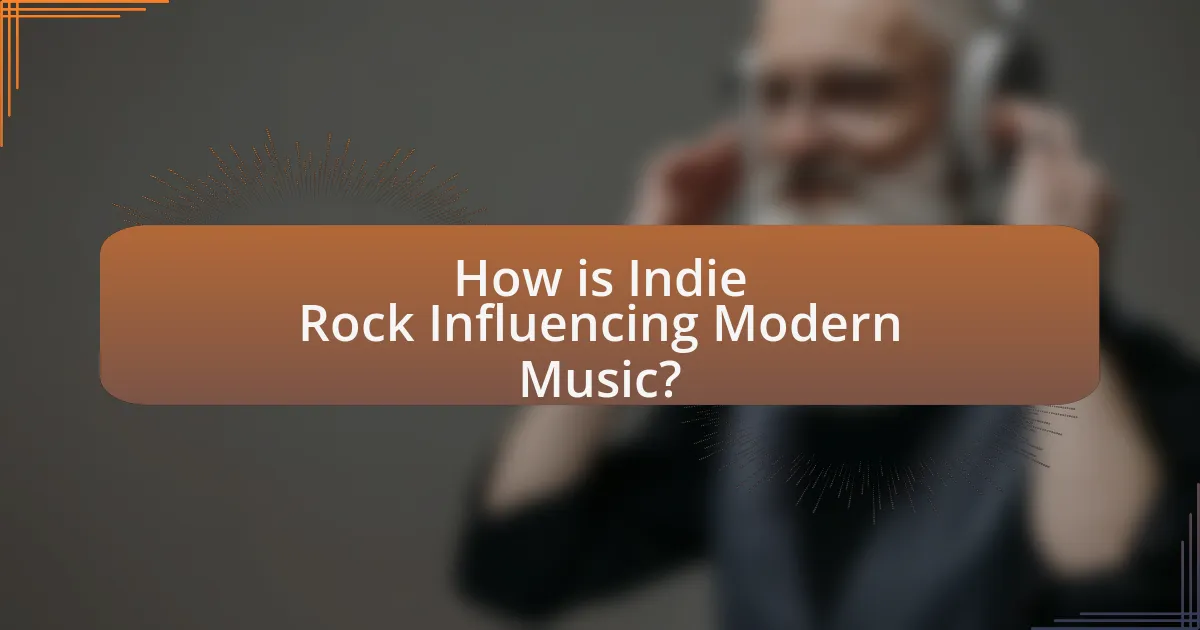
How is Indie Rock Influencing Modern Music?
Indie rock is influencing modern music by promoting diverse sounds, DIY ethics, and lyrical authenticity. This genre has encouraged mainstream artists to experiment with unconventional song structures and production techniques, leading to a broader acceptance of varied musical styles. For instance, albums like “In the Aeroplane Over the Sea” by Neutral Milk Hotel and “Funeral” by Arcade Fire have inspired contemporary musicians to prioritize emotional depth and narrative in their songwriting. Additionally, the rise of platforms like Bandcamp and SoundCloud, which are rooted in indie rock culture, has democratized music distribution, allowing independent artists to reach wider audiences without traditional label support. This shift has resulted in a more eclectic music landscape, where influences from indie rock are evident across pop, hip-hop, and electronic genres.
What are the defining characteristics of Indie Rock?
Indie Rock is characterized by its emphasis on independent production, a diverse range of musical styles, and a focus on artistic expression over commercial success. This genre often features unconventional song structures, introspective lyrics, and a DIY ethos, which allows artists to maintain creative control. Historically, the rise of Indie Rock in the 1980s and 1990s, with bands like R.E.M. and The Smiths, showcased a departure from mainstream music norms, leading to a flourishing of unique sounds and subgenres. The genre’s influence is evident in the way it has shaped modern music, encouraging artists to explore personal themes and innovative sounds outside of major label constraints.
How do these characteristics differentiate Indie Rock from mainstream genres?
Indie Rock is differentiated from mainstream genres primarily through its emphasis on artistic freedom, DIY ethics, and a focus on unique sound over commercial appeal. This genre often features unconventional song structures, diverse instrumentation, and lyrical content that explores personal or introspective themes, contrasting with the formulaic approaches commonly found in mainstream music. For instance, bands like Arcade Fire and The National exemplify this by prioritizing creative expression and authenticity, often producing music that challenges commercial norms. Additionally, the independent nature of many Indie Rock artists allows them to maintain control over their music production and distribution, further setting them apart from mainstream artists who typically operate within major label constraints.
What role do independent labels play in the Indie Rock scene?
Independent labels are crucial in the Indie Rock scene as they provide a platform for emerging artists to release their music without the constraints of major label expectations. These labels often prioritize artistic freedom, allowing musicians to explore their sound and vision, which fosters innovation within the genre. For instance, labels like Sub Pop and Matador Records have been instrumental in launching the careers of influential bands such as Nirvana and Pavement, respectively. This support not only helps artists gain exposure but also cultivates a diverse music landscape that challenges mainstream norms.
Why is Indie Rock considered a significant movement in music history?
Indie Rock is considered a significant movement in music history because it challenged mainstream music norms and fostered artistic independence. Emerging in the 1980s and gaining prominence in the 1990s, Indie Rock artists often produced music outside major record labels, allowing for greater creative freedom and diversity in sound. This movement led to the rise of influential bands such as R.E.M., The Smiths, and later, Arcade Fire and The Strokes, who not only shaped the sound of their eras but also inspired countless musicians across genres. The DIY ethos of Indie Rock has had a lasting impact on the music industry, encouraging a culture of self-production and distribution that continues to influence modern music today.
What cultural shifts have been influenced by Indie Rock?
Indie Rock has influenced significant cultural shifts, particularly in the realms of music consumption, fashion, and social attitudes. The rise of Indie Rock in the 1990s and 2000s led to a democratization of music production and distribution, as artists began to self-release music and utilize platforms like Bandcamp and SoundCloud, challenging traditional music industry norms. This shift encouraged a DIY ethos, fostering creativity and individuality among musicians and fans alike.
Moreover, Indie Rock has impacted fashion trends, promoting a more eclectic and personalized style that often blends vintage and contemporary elements, reflecting the genre’s diverse influences. Socially, Indie Rock has contributed to a greater acceptance of alternative lifestyles and perspectives, often addressing themes of identity, mental health, and social justice in its lyrics. This cultural influence is evident in the growing visibility of artists and issues within the genre, as well as the genre’s embrace of diverse musical styles and backgrounds.
How has Indie Rock contributed to the evolution of music genres?
Indie Rock has significantly contributed to the evolution of music genres by fostering a DIY ethos and encouraging genre-blending. This genre emerged in the 1980s and 1990s, characterized by independent production and distribution, which allowed artists to experiment outside mainstream constraints. For instance, bands like Sonic Youth and Pavement incorporated elements from punk, noise rock, and alternative music, influencing the development of subgenres such as lo-fi and post-rock. Additionally, the rise of digital platforms in the 2000s enabled indie artists to reach wider audiences, further blurring genre lines and inspiring mainstream artists to adopt indie aesthetics, as seen in the works of bands like Arcade Fire and The Lumineers. This cross-pollination has led to a more diverse musical landscape, where genres continuously evolve and intersect.
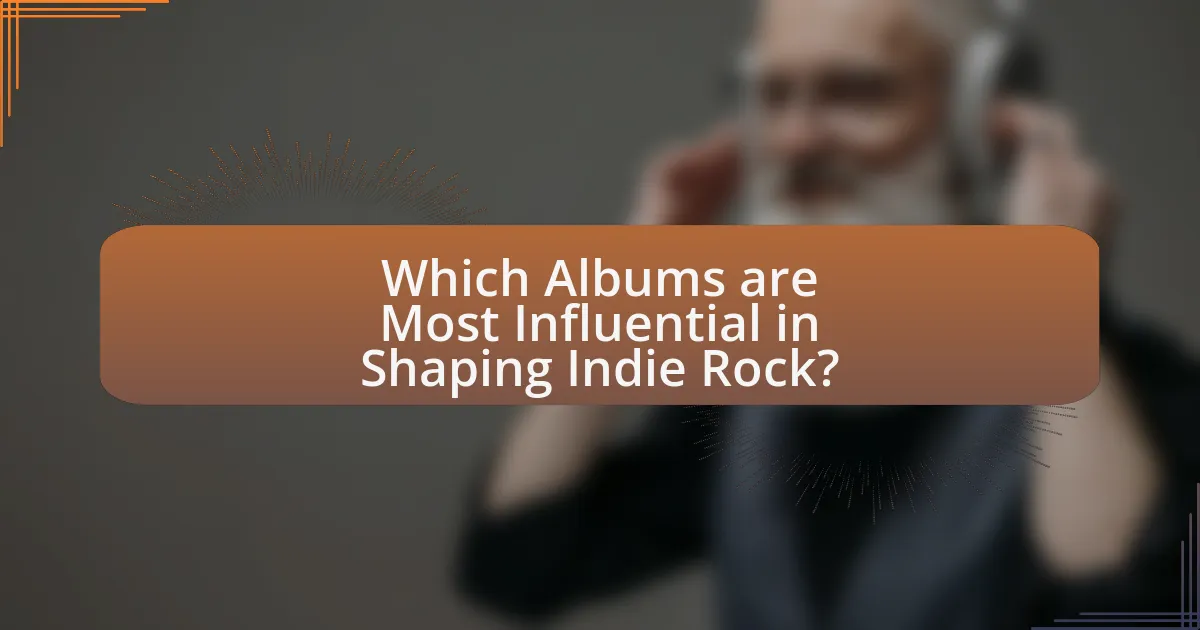
Which Albums are Most Influential in Shaping Indie Rock?
The most influential albums in shaping indie rock include “The Velvet Underground & Nico” by The Velvet Underground, “OK Computer” by Radiohead, and “Is This It” by The Strokes. “The Velvet Underground & Nico,” released in 1967, is often credited with laying the groundwork for alternative music, influencing countless artists with its experimental sound and lyrical depth. “OK Computer,” released in 1997, pushed the boundaries of rock music with its complex arrangements and themes of alienation, significantly impacting the genre’s evolution. “Is This It,” released in 2001, revitalized the garage rock scene and set the stage for a new wave of indie bands, showcasing a raw sound that resonated with a generation. These albums collectively represent pivotal moments in indie rock history, shaping its direction and inspiring future musicians.
What are some landmark albums in Indie Rock history?
Some landmark albums in Indie Rock history include “The Velvet Underground & Nico” by The Velvet Underground, “OK Computer” by Radiohead, and “Funeral” by Arcade Fire. “The Velvet Underground & Nico,” released in 1967, is often credited with influencing the sound and aesthetic of alternative music, showcasing experimental approaches to songwriting and production. “OK Computer,” released in 1997, is recognized for its complex themes and innovative soundscapes, marking a significant evolution in the genre. “Funeral,” released in 2004, is noted for its orchestral arrangements and emotional depth, helping to define the sound of 2000s indie rock. These albums have played pivotal roles in shaping the landscape of modern music.
How did these albums impact the sound of Indie Rock?
These albums significantly shaped the sound of Indie Rock by introducing diverse musical styles and innovative production techniques. For instance, the incorporation of lo-fi aesthetics and experimental sounds in albums like “The Velvet Underground & Nico” and “OK Computer” expanded the genre’s sonic palette, influencing countless artists. Additionally, the emotional depth and lyrical introspection found in works such as “Funeral” by Arcade Fire and “The Suburbs” further defined the thematic direction of Indie Rock, encouraging a more personal and narrative-driven approach to songwriting. This evolution is evidenced by the rise of bands like Bon Iver and Tame Impala, who draw directly from these influential albums, showcasing their lasting impact on the genre’s development.
What themes are prevalent in these influential albums?
Influential albums in indie rock often explore themes of introspection, identity, and social commentary. For instance, albums like “Funeral” by Arcade Fire delve into themes of loss and community, reflecting personal and collective experiences. Similarly, “In the Aeroplane Over the Sea” by Neutral Milk Hotel addresses themes of love and existentialism, drawing on historical and personal narratives. These thematic explorations resonate with listeners, fostering a deeper emotional connection and influencing the broader music landscape.
How have these albums influenced contemporary artists?
These albums have significantly influenced contemporary artists by shaping their musical styles, lyrical themes, and production techniques. For instance, the raw authenticity and DIY ethos of early indie rock albums have inspired a wave of artists to embrace lo-fi production and personal storytelling in their music. Notably, bands like Vampire Weekend and Tame Impala have cited influences from these albums, integrating eclectic sounds and introspective lyrics that reflect the indie rock legacy. Additionally, the genre’s emphasis on artistic independence has encouraged contemporary musicians to prioritize creative control, leading to a diverse range of sounds and innovative approaches in modern music.
Which modern artists cite these albums as inspirations?
Many modern artists cite influential indie rock albums as inspirations, including artists like Phoebe Bridgers, who has mentioned the impact of albums by Elliott Smith and Neutral Milk Hotel. Additionally, artists such as Bon Iver and Sufjan Stevens have drawn from the sounds and themes present in these albums, reflecting their influence on contemporary music. These artists often reference the emotional depth and innovative production techniques found in the works of their indie rock predecessors, showcasing the lasting legacy of these albums in shaping their own musical styles.
What elements from these albums can be found in today’s music?
Elements from influential indie rock albums, such as lo-fi production, introspective lyrics, and unconventional song structures, are prevalent in today’s music. For instance, the use of lo-fi aesthetics can be heard in contemporary artists like Phoebe Bridgers and Mac DeMarco, who incorporate raw sound quality to evoke authenticity. Additionally, introspective and personal lyrics, a hallmark of albums like “The Suburbs” by Arcade Fire, resonate in the works of modern singer-songwriters, reflecting a trend towards vulnerability in songwriting. Unconventional song structures, often seen in albums like “In the Aeroplane Over the Sea” by Neutral Milk Hotel, influence current musicians who prioritize artistic expression over traditional pop formats. These elements demonstrate the lasting impact of indie rock on the current musical landscape.
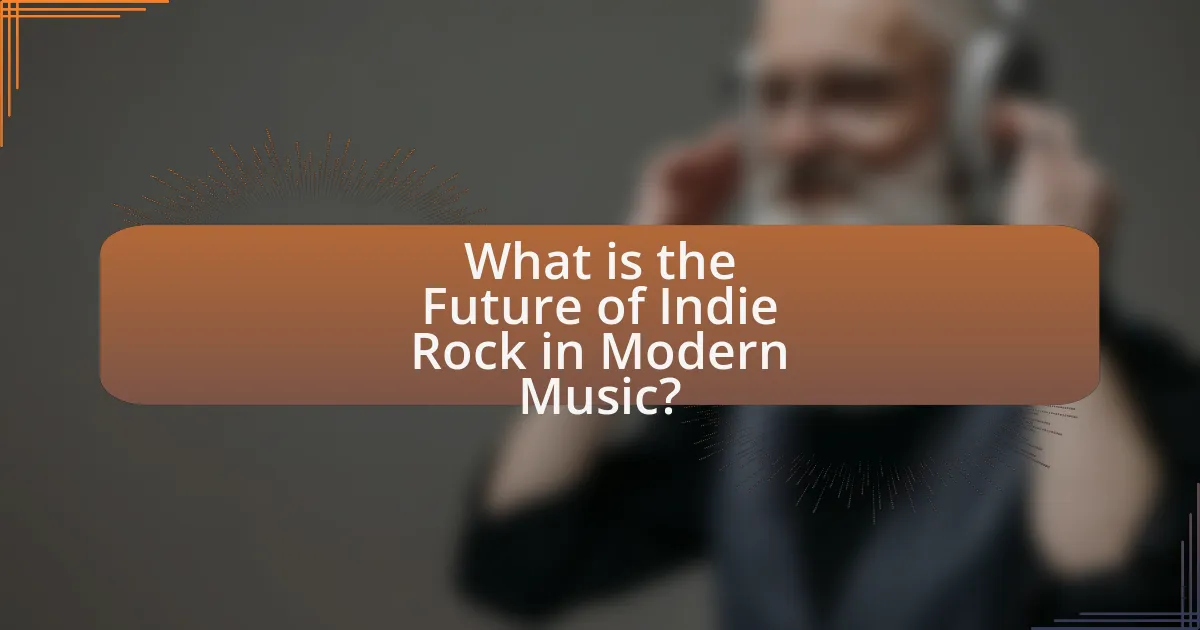
What is the Future of Indie Rock in Modern Music?
The future of indie rock in modern music is characterized by its increasing integration with mainstream genres and the rise of digital platforms for distribution. As artists leverage streaming services and social media, indie rock is becoming more accessible, allowing for diverse influences and collaborations that expand its sound. For instance, the blending of indie rock with electronic and hip-hop elements has been evident in recent albums, showcasing a shift towards genre fluidity. This evolution is supported by data indicating that indie rock artists are gaining significant traction on platforms like Spotify, where playlists featuring indie tracks have millions of followers, reflecting a growing audience. Additionally, the success of indie labels in nurturing talent demonstrates the genre’s resilience and adaptability in a rapidly changing music landscape.
How is Indie Rock evolving in the digital age?
Indie Rock is evolving in the digital age through increased accessibility and the rise of independent distribution platforms. Artists can now release music directly to audiences via streaming services like Spotify and Bandcamp, bypassing traditional record labels. This shift has led to a diversification of sounds and styles within the genre, as musicians experiment with new technologies and collaborate globally. According to a 2021 report by the International Federation of the Phonographic Industry, independent labels accounted for 40% of global recorded music revenue, highlighting the significant impact of digital platforms on the indie music landscape.
What role does social media play in promoting Indie Rock artists?
Social media plays a crucial role in promoting Indie Rock artists by providing them with platforms to reach wider audiences without the need for traditional marketing channels. These platforms, such as Instagram, Twitter, and TikTok, enable artists to share their music, engage with fans, and build a community around their brand. For instance, a study by the University of Southern California found that 70% of music listeners discover new artists through social media, highlighting its effectiveness in artist promotion. Additionally, social media allows for real-time feedback and interaction, which can enhance an artist’s visibility and fan loyalty, further solidifying its importance in the Indie Rock scene.
How are streaming platforms changing the landscape for Indie Rock?
Streaming platforms are significantly transforming the landscape for Indie Rock by providing artists with unprecedented access to global audiences. These platforms, such as Spotify and Apple Music, enable independent musicians to distribute their music without the need for traditional record labels, allowing for greater creative freedom and financial control. According to a 2021 report by the International Federation of the Phonographic Industry, streaming accounted for 62% of global recorded music revenue, highlighting its dominance in the industry. This shift has led to a surge in the discovery of new Indie Rock artists, as algorithms and curated playlists promote diverse sounds and styles, fostering a more inclusive music ecosystem.
What challenges does Indie Rock face in the current music industry?
Indie Rock faces significant challenges in the current music industry, primarily due to market saturation and the dominance of mainstream genres. The rise of digital streaming platforms has made it easier for artists to distribute their music, but it has also led to an overwhelming amount of content, making it difficult for Indie Rock bands to stand out. According to a 2021 report by the International Federation of the Phonographic Industry, independent labels accounted for only 30% of global recorded music revenue, highlighting the financial struggles faced by Indie Rock artists compared to their mainstream counterparts. Additionally, the shift in consumer behavior towards playlists and algorithm-driven recommendations often sidelines Indie Rock in favor of more commercially viable genres, further complicating visibility and audience engagement for these artists.
How do market trends affect the production of Indie Rock music?
Market trends significantly influence the production of Indie Rock music by dictating the styles, themes, and distribution methods that artists adopt. For instance, the rise of streaming platforms has shifted focus towards singles and shorter albums, prompting Indie Rock musicians to produce more concise and commercially viable tracks. Additionally, trends in social media engagement have led artists to prioritize music that resonates with current cultural movements, often resulting in collaborations that reflect popular aesthetics. According to a 2021 report by the International Federation of the Phonographic Industry, 70% of music consumption now occurs via streaming, which has directly impacted how Indie Rock artists approach their production and marketing strategies.
What strategies can Indie Rock artists use to thrive today?
Indie Rock artists can thrive today by leveraging digital platforms for music distribution and fan engagement. Utilizing streaming services like Spotify and Apple Music allows artists to reach a global audience, while social media platforms such as Instagram and TikTok enable direct interaction with fans, fostering a loyal community. According to a 2021 report by the International Federation of the Phonographic Industry, streaming accounted for 62.1% of global recorded music revenue, highlighting the importance of digital presence for artists. Additionally, Indie Rock artists can benefit from collaborating with other musicians and participating in virtual events, which can enhance visibility and create new opportunities for exposure.
What can listeners do to support Indie Rock artists?
Listeners can support Indie Rock artists by purchasing their music and merchandise directly from their websites or platforms like Bandcamp. This direct financial support allows artists to retain a larger portion of their earnings compared to streaming services, where they receive minimal compensation. Additionally, attending live shows and promoting these events through social media increases visibility and helps build a dedicated fan base. According to a 2020 report by the Music Industry Research Association, live performances account for a significant portion of an artist’s income, particularly for independent musicians. Engaging with artists on social media by sharing their content and leaving positive reviews also fosters a supportive community, encouraging further creativity and production.
How can fans engage with Indie Rock communities?
Fans can engage with Indie Rock communities by participating in online forums, attending local shows, and following social media pages dedicated to Indie Rock artists. Online platforms like Reddit and Facebook host groups where fans discuss music, share recommendations, and connect with like-minded individuals. Attending local shows allows fans to support Indie bands directly and meet other fans in person, fostering a sense of community. Additionally, following artists on social media provides fans with updates on new releases and events, creating opportunities for interaction and engagement. These methods are effective as they facilitate direct communication and shared experiences among fans, enhancing their connection to the Indie Rock scene.
What are the best ways to discover new Indie Rock music?
The best ways to discover new Indie Rock music include exploring music streaming platforms, attending live shows, and following music blogs and social media channels dedicated to the genre. Music streaming platforms like Spotify and Apple Music offer curated playlists and algorithm-driven recommendations based on listening habits, which can introduce listeners to emerging Indie Rock artists. Attending live shows and festivals allows fans to experience new bands firsthand and often discover local talent. Additionally, music blogs such as Pitchfork and Stereogum, along with social media accounts focused on Indie Rock, provide insights and recommendations on the latest releases and underground artists, making them valuable resources for discovering new music.
